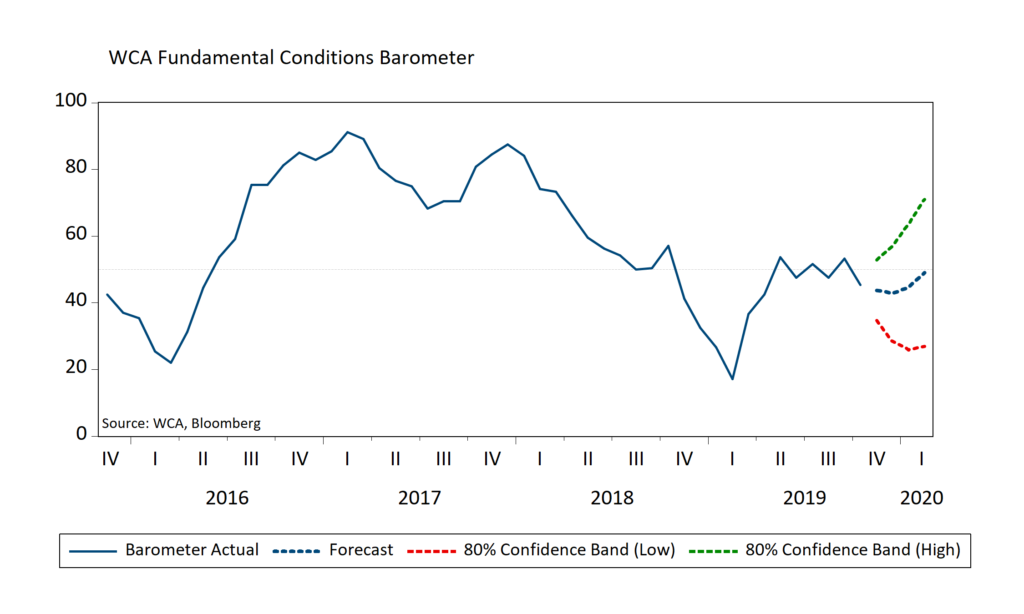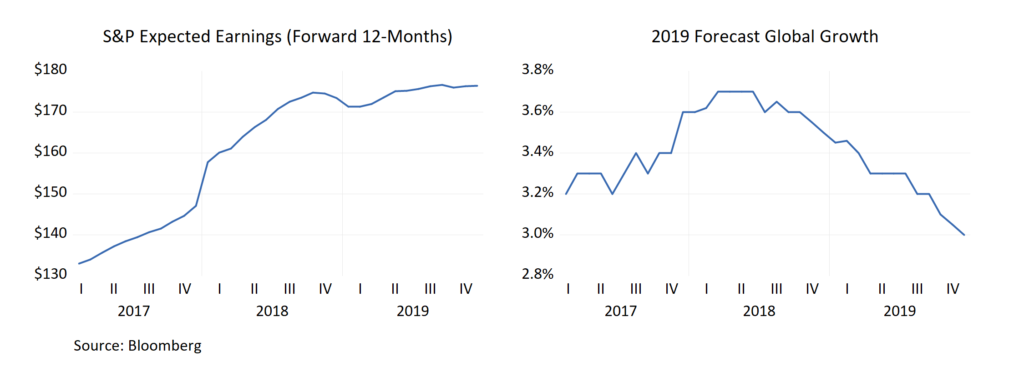Up, Down, Sideways, Repeat
The past few months, our WCA Fundamental Conditions Barometer (Table A) has bounced around sideways with no real direction. This sideways behavior comes after a monetary policy induced spring surge. With markets now in sync with central bank messaging, there is little new impetus to drive risk appetite. Ahead lies the prospect that a partial trade deal with China could bolster confidence, reenergize growth, and boost corporate earnings.

Missing Link
The missing link in the argument for a furthering of the current bull market is in the earnings story. Growth is critically important for any long-run bullish argument for stocks. With 40% of S&P 500 earnings coming from outside the United States, global growth is just as important as domestic growth. According to estimates from a Bloomberg survey, 2019 global growth (chart C , below right) is now down to about 3% from 3.7% in mid-2018. Here in the United States, the Federal Reserve Bank of Atlanta’s GDP Now survey for the current quarter is just below 2% versus 3% in the six quarters prior to mid-2018. Around about the same time that growth concerns crept in, the upward climb of earnings forecasts also hit a wall (chart B, below left). Since mid-2018, there has been no material increase in S&P 500 earnings per share (EPS) estimates by analysts. Clearly, the impact of trade worries, slowing global and domestic growth have held back corporate earnings prospects.

Conclusion and Portfolio Posture
In order for the bull case to strengthen from here, it is important that the growth outlook brightens. Multiple expansion and central bank liquidity can only carry the water so far, at some point we need to see a pickup in growth. For now, the jury seems to be out whether or not this will materialize. The latest monthly forecast of our WCA Fundamental Conditions Barometer underscores more of the up, down, sideways, repeat pattern we’ve seen since the start of summer.
In keeping with our discipline, we’ve adjusted downward the equity exposure in the CONQUEST tactical portfolios to 45% from 55% equity exposure in the short-term, satellite portion of portfolios. This level of equity exposure aligns the stock-bond mix to the near-term barometer forecast.
Kevin
Caron, CFA, Senior Portfolio Manager
Chad Morganlander, Senior Portfolio Manager
Matthew Battipaglia, Portfolio Manager
Steve Lerit, CFA, Client Portfolio Manager
Suzanne Ashley, Analyst
(973) 549-4168
Disclosures
WCA Fundamental Conditions Barometer Description: We regularly assess changes in fundamental conditions to help guide near-term asset allocation decisions. The analysis incorporates approximately 30 forward-looking indicators in categories ranging from Credit and Capital Markets to U.S. Economic Conditions and Foreign Conditions. From each category of data, we create three diffusion-style sub-indices that measure the trends in the underlying data. Sustained improvement that is spread across a wide variety of observations will produce index readings above 50 (potentially favoring stocks), while readings below 50 would indicate potential deterioration (potentially favoring bonds). The WCA Fundamental Conditions Index combines the three underlying categories into a single summary measure. This measure can be thought of as a “barometer” for changes in fundamental conditions.
The information contained herein has been prepared from sources believed to be reliable but is not guaranteed by us and is not a complete summary or statement of all available data, nor is it considered an offer to buy or sell any securities referred to herein. Opinions expressed are subject to change without notice and do not take into account the particular investment objectives, financial situation, or needs of individual investors. There is no guarantee that the figures or opinions forecasted in this report will be realized or achieved. Employees of Stifel, Nicolaus & Company, Incorporated or its affiliates may, at times, release written or oral commentary, technical analysis, or trading strategies that differ from the opinions expressed within. Past performance is no guarantee of future results. Indices are unmanaged, and you cannot invest directly in an index.
Asset allocation and diversification do not ensure a profit and may not protect against loss. There are special considerations associated with international investing, including the risk of currency fluctuations and political and economic events. Investing in emerging markets may involve greater risk and volatility than investing in more developed countries. Due to their narrow focus, sector-based investments typically exhibit greater volatility. Small company stocks are typically more volatile and carry additional risks, since smaller companies generally are not as well established as larger companies. Property values can fall due to environmental, economic, or other reasons, and changes in interest rates can negatively impact the performance of real estate companies. When investing in bonds, it is important to note that as interest rates rise, bond prices will fall. High-yield bonds have greater credit risk than higher-quality bonds. The risk of loss in trading commodities and futures can be substantial. You should therefore carefully consider whether such trading is suitable for you in light of your financial condition. The high degree of leverage that is often obtainable in commodity trading can work against you as well as for you. The use of leverage can lead to large losses as well as gains.
All investments involve risk, including loss of principal, and there is no guarantee that investment objectives will be met. It is important to review your investment objectives, risk tolerance and liquidity needs before choosing an investment style or manager. Equity investments are subject generally to market, market sector, market liquidity, issuer, and investment style risks, among other factors to varying degrees. Fixed Income investments are subject to market, market liquidity, issuer, investment style, interest rate, credit quality, and call risks, among other factors to varying degrees.
This commentary often expresses opinions about the direction of market, investment sector and other trends. The opinions should not be considered predictions of future results. The information contained in this report is based on sources believed to be reliable, but is not guaranteed and not necessarily complete.
Washington Crossing Advisors LLC is a wholly owned subsidiary and affiliated SEC Registered Investment Adviser of Stifel Financial Corp (NYSE: SF)



